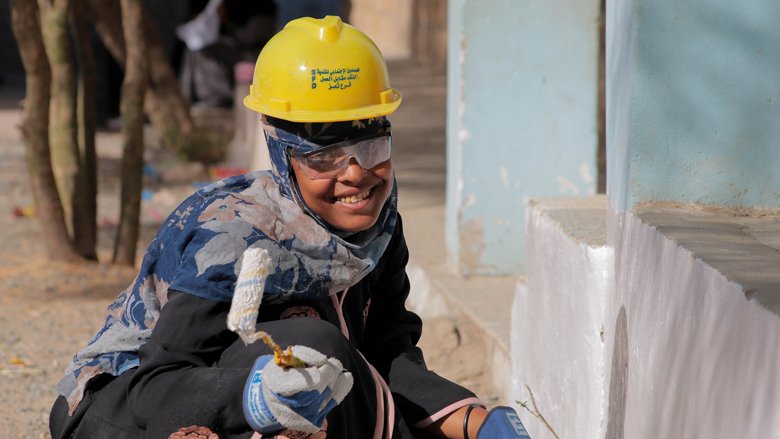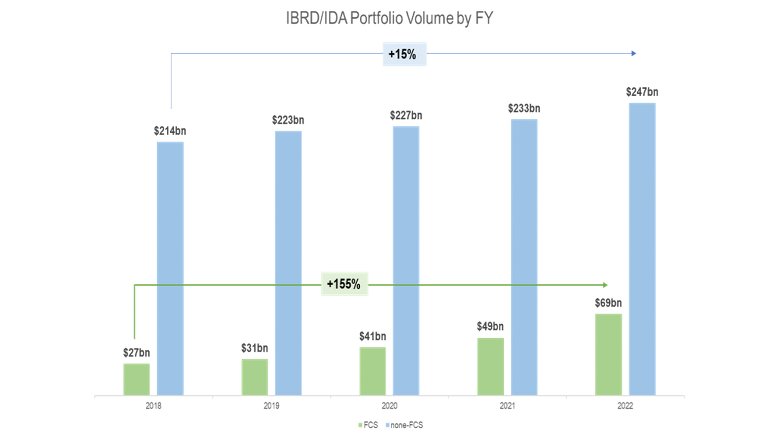CHALLENGE
A Worsening Landscape of Poverty and Violence
By 2030, an estimated 59 percent of the world’s poorest people will live in countries impacted by fragile and conflict-affected situations, where severe food insecurity is twice as prevalent as elsewhere. Conflicts, violence and fragility are also leading to increased levels of forced displacement; as of mid-2022, more than 108 million people were estimated to be forcibly displaced globally. Rising inequality and economic exclusion fuel grievances, while compounding challenges like climate change, displacement, illicit financial flows, violent extremism, and poor governance exacerbate and entrench fragility, vulnerability, and conflict in many countries. Among the 20 countries most vulnerable to climate change, 15 are FCS, and nine of these are also food insecure. COVID-19 pushed about 20 million more people living in FCS countries into extreme poverty, and heightened existing FCV risks. Progress toward the World Bank’s goal of ending extreme poverty in a livable world and the shared global commitment to the Sustainable Development Goals (SDGs) requires a strong focus on tackling FCV.
APPROACH
Addressing the Drivers of Fragility, Conflict and Violence
Responding to an increasingly complex fragility landscape, the World Bank is taking a broader approach to FCV, addressing the sources of instability, building resilience, and remaining engaged both during active conflict and recovery and transition.
A record-breaking $30 billion in financing for FCV-affected countries, approved in December 2021 under the International Development Association’s (IDA) 20th replenishment (IDA20), has been tailored to the diverse challenges facing the poorest countries. These countries will also have access to additional IDA resources to address specific thematic issues, enabling them to receive support at every stage of the conflict cycle: helping prevent conflict escalation, remaining engaged during crisis and post-crisis situations to preserve human capital and key institutions, and helping create development opportunities for refugees and host communities.
Remaining engaged during conflict and crisis situations to preserve development gains, protect essential institutions, build resilience, and be ready for future recovery is one of the pillars of the World Bank FCV strategy. The World Bank is responsive to the needs of the most vulnerable people, especially women and children living in volatile situations, who are disproportionately affected by conflict. Remaining engaged aims to ensure access to basic services like food, water, and healthcare, while staying the course on development and institution-building. The World Bank works with partners to deliver financing, analytics, and global advocacy to solve development challenges in FCS, and works with the private sector to create jobs, build infrastructure, and develop markets, leading to economic growth.
RESULTS
Remaining Engaged to Pursue Development Goals in FCV-affected Countries
The World Bank has shown that it can remain engaged even in the most challenging FCV situations, working closely with partners and rapidly adapting operations to cope with mounting risks. A 2021 Independent Evaluation Group (IEG) report found that more than 80 percent of emergency operations approved during irregular political transitions effectively maintained critical service delivery.
The World Bank’s engagement in FCV-affected regions has increased significantly in the last half-decade. The share of IDA financing going to FCV-affected states has increased threefold from IDA16 to IDA19, reaching 42 percent of total IDA resources. Remaining Engaged during Conflict Allocation (RECA) financing, in particular, enables the World Bank to continue engagement in IDA countries with high-intensity conflict and extremely limited government capacity. In South Sudan, for example, RECA support has facilitated an ambitious expansion of the World Bank portfolio.
In Haiti, where economic and social development continue to be hindered by political instability and increasing violence, the Adaptive Social Protection for Increased Resilience Project (ASPIRE) supports almost 23,000 households in the department of Grand’Anse with a monthly cash transfer. This enables them to build resilience against the shocks of recurring violence or disasters, such as the earthquake of August 2021. Half of these families will be provided with capacity building in financial literacy and best practices in hygiene, nutrition, and maternal and child health, to further improve their resilience. The project has also helped identify over 100,000 vulnerable households who have already been registered with the Ministry of Social Welfare and Labor, thus helping other government and non-government programs prioritize their investments. The project addresses immediate humanitarian needs, while laying the foundations for human capital investments over the medium and longer terms.
In Myanmar, the National Community-Driven Development Project, endorsed immediately after the World Bank re-engaged with Myanmar in November 2012, was designed to support a more people-centered and bottom-up approach to development. This $480 million project (financed by IDA grants and credits) has benefited more than 7 million people in 63 townships (20 percent of the country’s population) and more than 12,000 villages, through approximately 37,000 sub-projects that improve basic infrastructure and services in transport, water, schools, and electrification. In 2014 the World Bank, with development partners Australian Aid, UK Aid, and the governments of Denmark and Finland, established the Myanmar Partnership Multi-Donor Trust Fund (MDTF) to promote aid coordination, collaboration, and joint financing of activities in line with the national development strategy. The MDTF worked in sectors such as education, governance, and private sector development to support Myanmar’s transition and implementation of the government’s Framework for Economic and Social Reform and National Development Plan. While the World Bank has halted disbursements in response to the military takeover of February 2021, it remains engaged through analytical activities, including up-to-date monitoring of the situation to better inform development partners and other stakeholders.
Partnerships and third-party implementation (TPI) through the United Nations (UN) and other international partners such as the International Committee of the Red Cross (ICRC) have proven crucial when government capacity is limited or engagement is otherwise constrained, and where World Bank presence is limited. Direct financing to third parties in FCS, from both IDA and trust fund resources, has increased in order to maintain some level of engagement in situations where the World Bank is unable to operate through governments.
Partnerships have helped preserve development gains in Afghanistan, where the World Bank’s engagements had achieved some signal development results. Real per capita income increased 75 percent between 2001 and 2020, and the number of connections to the electricity grid increased sevenfold. Secondary-age school enrollments increased from 13 percent to 54 percent between 2003 and 2017, and the youth literacy rate increased from 47 percent in 2011 to 67 percent in 2018. The fertility rate declined from 7.3 births per woman in 2002 to 4.6 births per woman in 2017, and 142 more children survive to the age of five for every 1,000 births today. These gains were supported by the Afghanistan Reconstruction Trust Fund (ARTF), which remains the largest single-country multi-donor trust fund in the World Bank, focused on social service delivery, private sector development, and institutional strengthening. While disbursements in Afghanistan were halted after August 2021, to safeguard these achievements, projects are now implemented through UN agencies and international nongovernmental organizations (INGOs). Direct World Bank support is provided for basic service delivery and livelihoods.
Country teams are increasingly innovating with real-time conflict risk identification and monitoring to remain engaged and adaptive in the most insecure environments. Local knowledge and the ability to interpret events to inform real-time decision making is critical to these efforts. Conflict tracking initiatives are ongoing in the Sahel, Horn of Africa, and South Sudan, where the Horn of Africa dashboard, financed by a multi-donor trust fund, has become an important tool for strategic oversight of the growing regional portfolio. IBRD/IDA is also collaborating with organizations, such as the International Crisis Group, that provide regular briefings to country teams on FCV dynamics in these regions.

